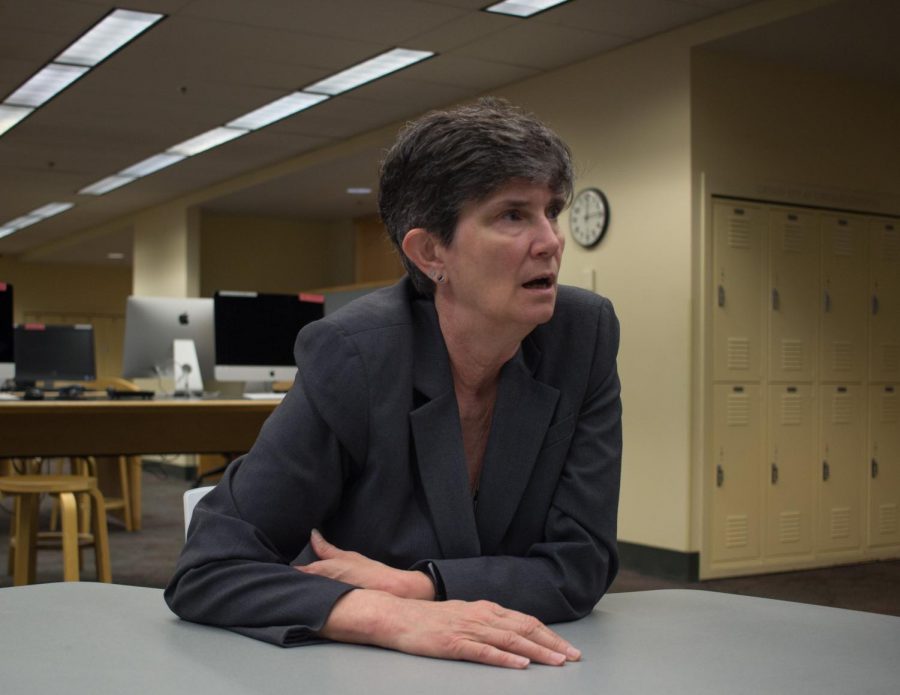White supremacist messages found on campus
April 10, 2017
Bias Response Team creates education opportunities, spaces for dialogue
Several white supremacist fliers were found on the second floor of OSU’s Valley Library on March 23, and in study rooms on March 25, according to Faye Chadwell, Donald and Delpha Campbell university librarian and OSU press director.
Additionally, two bias reports of white supremacist messages in residence halls were filed over spring break, according to Teresita Alvarez-Cortez, director of diversity initiatives and programs for University Housing and Dining Services.
Bias incidents create unwelcome atmospheres for those they are biased against, and tend to have a negative effect on both communities and individuals, according to the OSU Institutional Diversity webpage. When these incidents occur, OSU offers bias reporting as a resource to alert the university administration, so they may become involved through removing any physical biased material, as well as providing education and support to the community.
“Bias incidents have one important factor in common: they create a hostile working, learning or living environment and frequently have a negative psychological, emotional or physical effect on individuals and communities,” the OSU Institutional Diversity website reads.
Chadwell believes bias incidents create an unwelcome atmosphere in the library.
“Their message is not something we want to communicate. This is not who we are as an organization,” Chadwell said. “When you walk into the library, everyone is welcome.”
According to Alvarez-Cortez, bias incidents are also problematic for students in UHDS buildings.
“Bias incidents may have an impact on any community space, but especially in a living and dining environment where students create their home on campus,” Alvarez-Cortez said.
Ame Mañon, a student at OSU, believes the fliers to be indicative of something greater.
“It should be always taken seriously. I was pretty scared. What is their next step after fliers? It’s definitely a larger issue,” Mañon said.
However, not all students felt as impacted. Dan Hansen, an OSU student, is not concerned about the fliers.
“They’re a nuisance. No one is going to follow up on them,” Hansen said.
When confronted with a bias incident such as the white supremacist fliers, OSU community members should report it using the online bias report form, according to Scott Vignos, the director of strategic initiatives for the OSU Office of Institutional Diversity.
“When the Bias Response Team receives a bias incident report, it coordinates with university partners to provide care and support to community members who may be negatively affected,” Vignos said.
According to Vignos, bias incidents can sometimes qualify as free speech, but the university can speak out against hateful acts or statements.
“Bias incidents—words and actions that target individuals and communities based on an identity—can also be free speech. And freedom of speech generally cannot be denied because an opinion or the language used to express an opinion is highly offensive, unpopular or absurd,” Vignos said.
However, according to Vignos, “When statements or actions run counter to Oregon State’s values and its commitment to ensuring equitable educational opportunities, then the university can exercise its own right to speak out against such statements and actions, work to restore community and educate individuals about the responsibility all Oregon State community members share to treat each other with respect and dignity,” Vignos said.
Online bias reporting has been a resource for the OSU community since early 2016, according to Vignos.
“The bias incident reporting and response process has created a comprehensive resource for students and community members and has helped the university coordinate responses to these incidents.”
According to Alvarez-Cortez, when biased materials are reported in residence halls, UHDS will respond.
“We believe (biased materials) compromise an inclusive learning and living environment that every student should have the right to experience at OSU,” Alvarez-Cortes said. “In some cases it’s appropriate to simply remove the vandalism, while in many other cases the response is more involved and includes creating educational opportunities and spaces for dialogue.”
If biased material is found in the library, Chadwell encourages reporting it to the library staff.
“We want them to tell a staff person. We also will fill out a bias report if the person doesn’t want to, in addition to our internal report.”
While Mañon appreciates OSU’s communication to students about bias incidents, she hopes to have the opportunity to share her thoughts.
“I like that they notified students. I wish they’d been a little more proactive and start a conversation on ideas with students,” Mañon said. “It’s important to stay transparent and proactive.”
According to Vignos, the university will continue to develop in its response to bias incidents.
“We are currently developing additional campus resources in collaboration with university partners, including bystander bias incident prevention training,” Vignos said.
In the meantime, members of the OSU community who feel targeted are always welcome in the cultural centers, according to Jianwen Yin, a student employee at the Asian and Pacific cultural center.
“That’s why we are here. We provide a welcome environment. We support them. They are not alone,” Yin said.
For more information on bias incidents and bias reporting, visit the Bias Incident Response webpage on the OSU Institutional Diversity website.











































































































